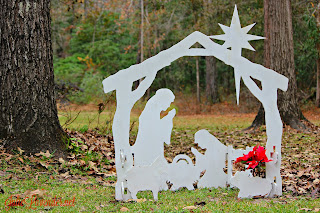CONSIDER THE POINSETTIA
by Julie Lavender
Though
it’s not native to the United States and serves as a Christmas-season décor,
the poinsettia is the spotlight of my blog this week.
I noticed my first of the season in my neighbor’s wooden nativity scene while on my morning walk.
I noticed my first of the season in my neighbor’s wooden nativity scene while on my morning walk.
Native
to Mexico, the shrub boasts brilliant red leaves – that most people falsely
call flowers – during the holiday season. Yet, to achieve that coloration,
growers have to “trick” the plant.
The plant will only display the colored bracts if it experiences complete darkness
for at least twelve hours per night for ten weeks. Growers trick the plants
into thinking they’re experiencing winter-time short days by placing blackout
cloths over the plants or greenhouses.
PERFECT TIMING
Only perfect timing will encourage the plants to turn red in time for Christmas.
Left alone, the red doesn’t appear until late January or February.
The
poinsettia is sometimes called the “Christmas Star,” because of the star-shape
formed by the brilliantly colored leaves.
A CROWN OF BEAUTY
Tiny poinsettia flowers cluster
together in the center of the star like a beautiful crown.
I
couldn’t help but be reminded by the poinsettia that a time of darkness in our
lives can often bring about a beautiful response. A learned lesson, a softened
heart, a renewed relationship, a closer walk with the Lord.
FESTIVE PRAISE
God never lets our darkness be the end
result. He never leaves us nor forsakes us during that time, and when we come
out on the other side, it’s often with brilliance and great beauty.
Dear God, please
help me feel your presence during the dark times. Remind me often of your
promise, “a joyous blessing instead of mourning,” until my ashes bring forth
beauty that glorifies you.








No comments:
Post a Comment